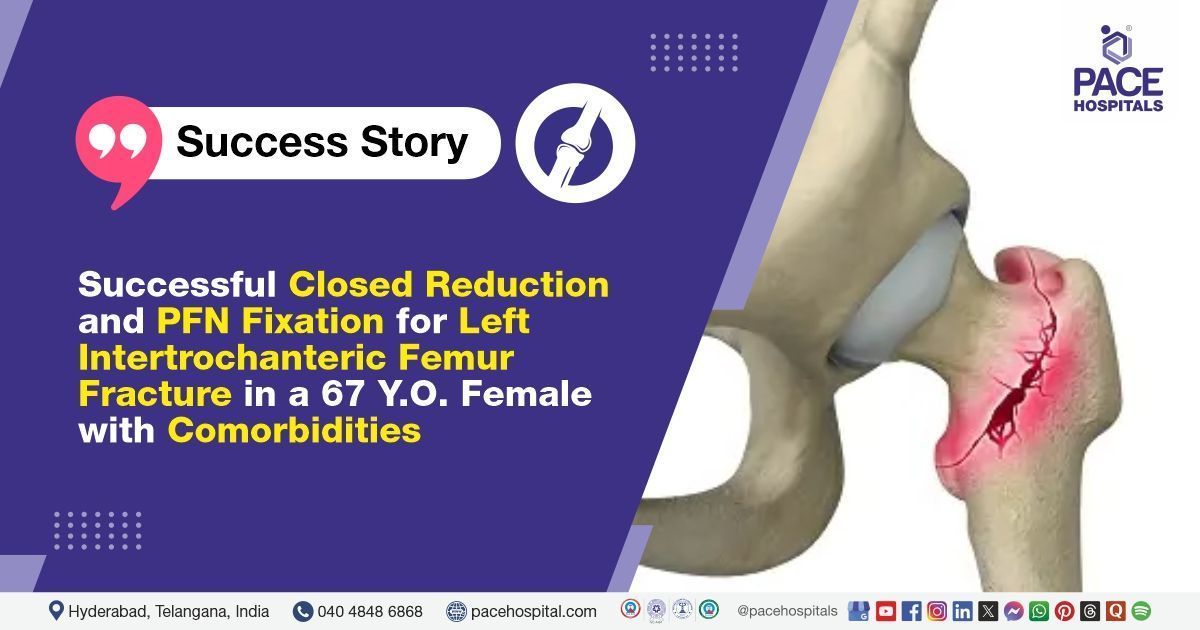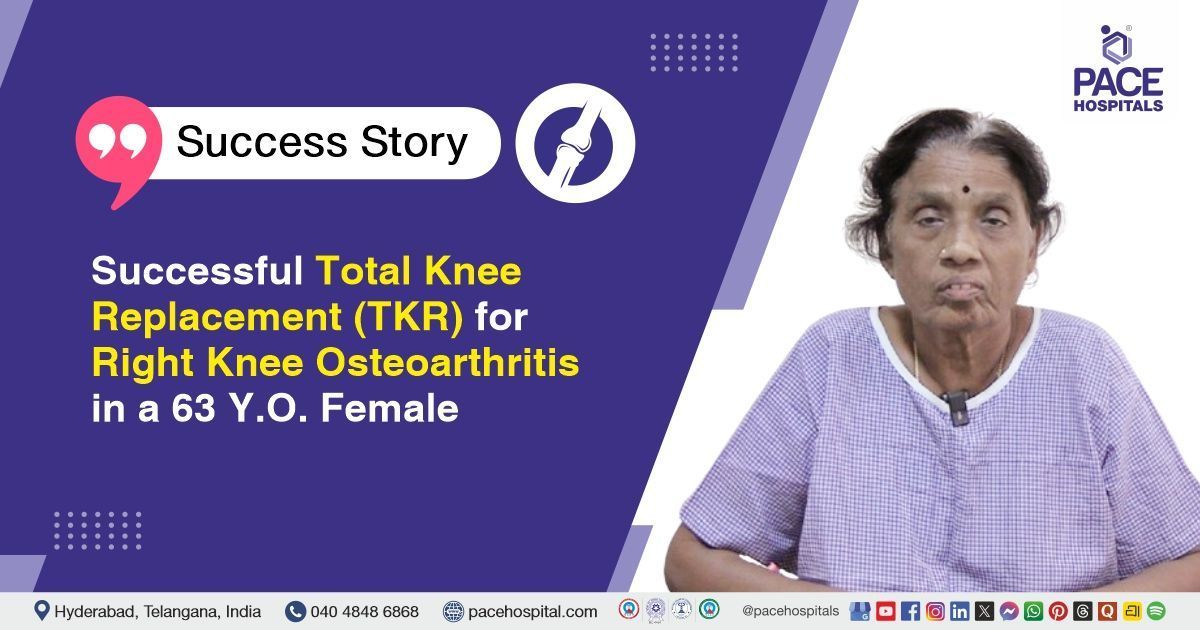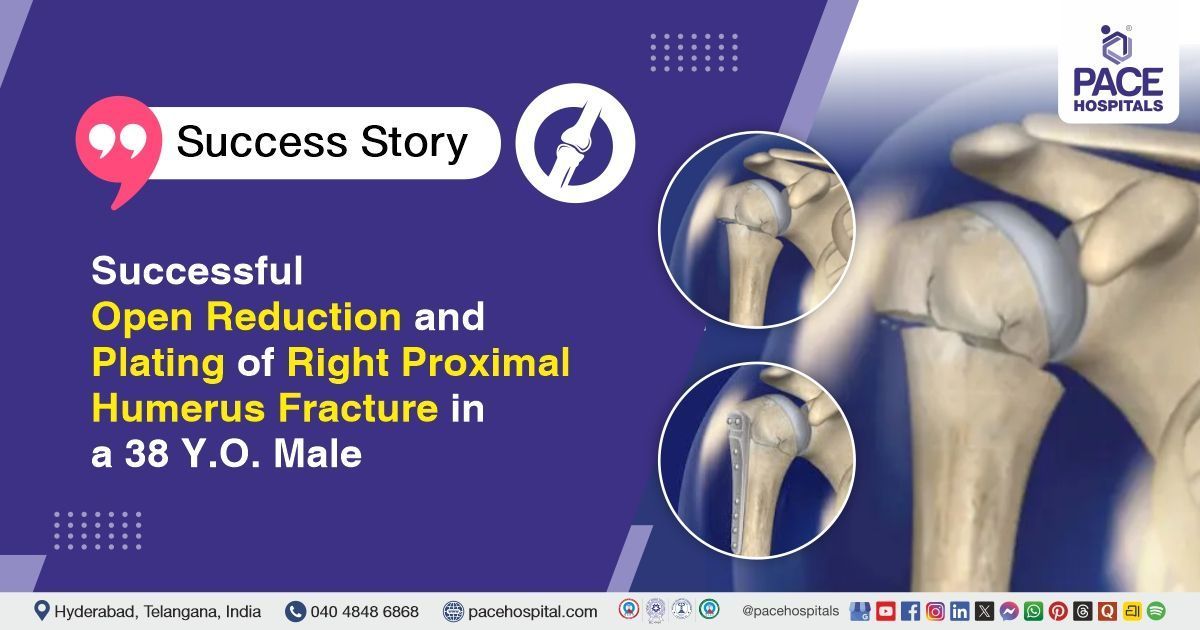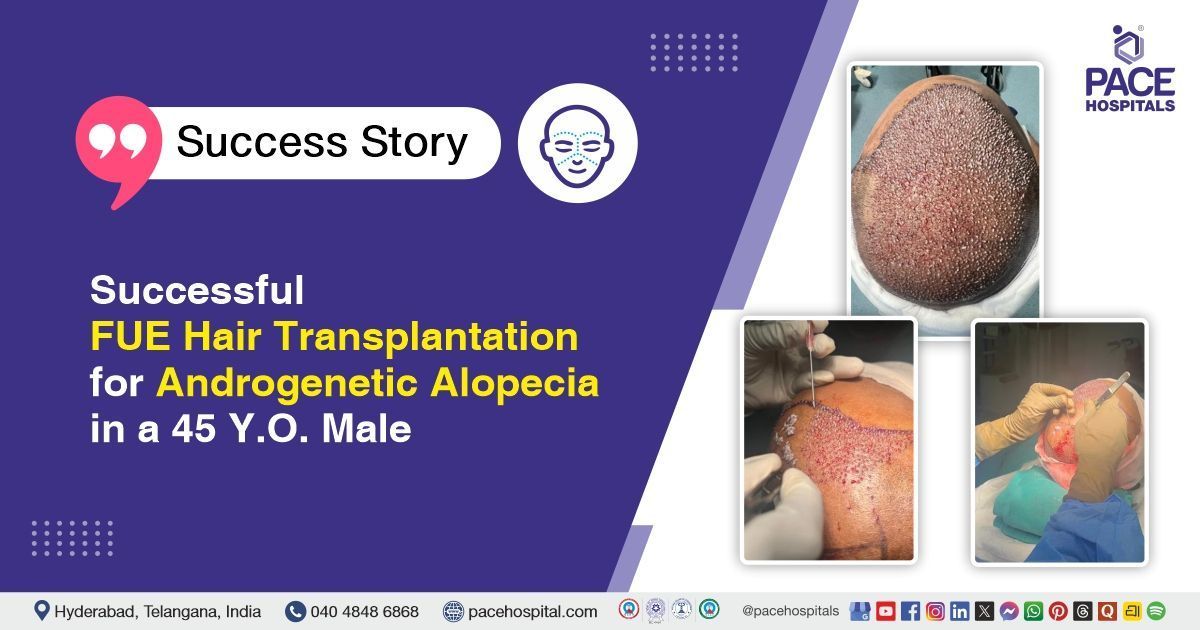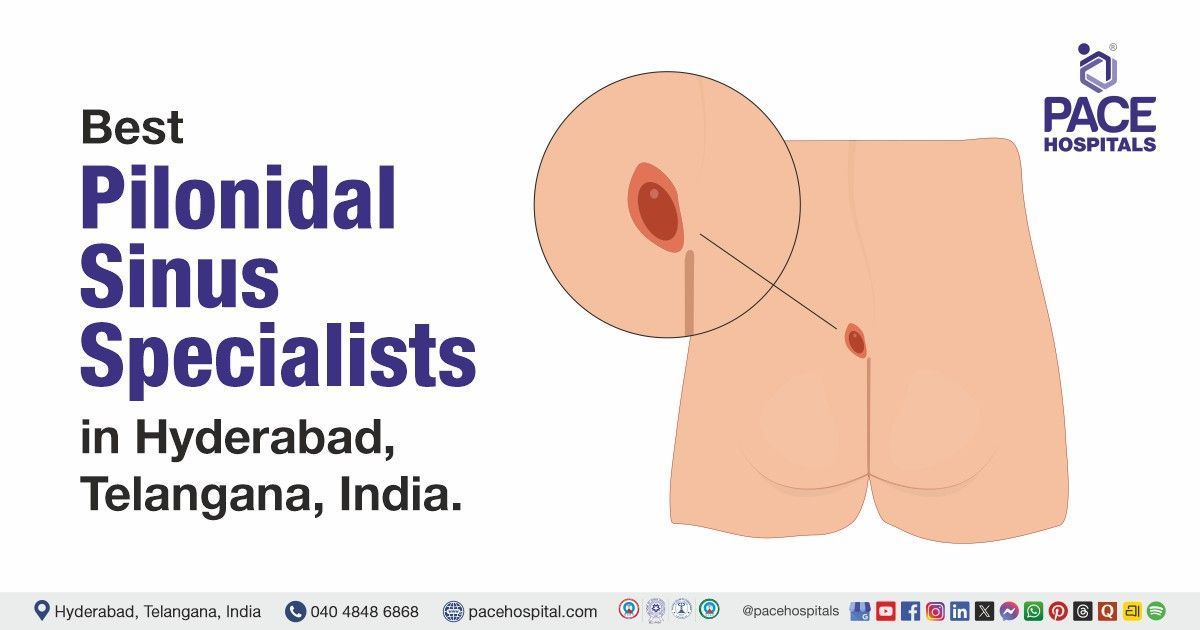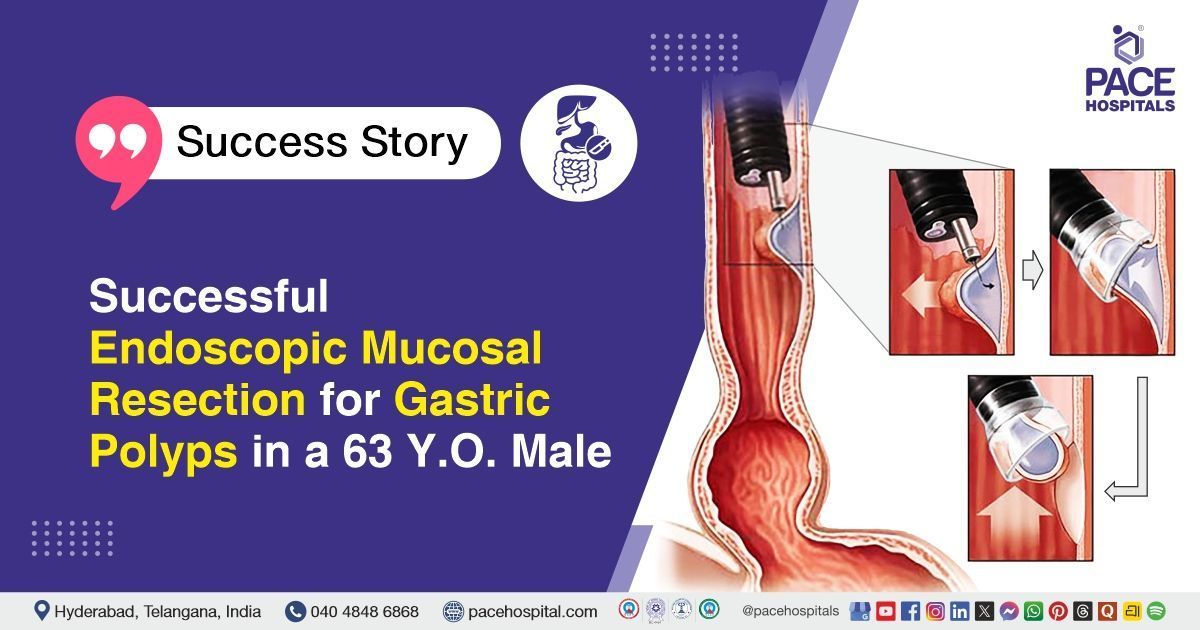Successful Closed Reduction and PFN Fixation for Left Intertrochanteric Femur Fracture in a 67-Y.O Female with Comorbidities
PACE Hospitals
PACE Hospitals’ expert orthopaedic team successfully performed a
Closed Reduction and Proximal Femoral Nail (PFN) fixation on a 67-year-old female patient diagnosed with an intertrochanteric fracture of the left femur. The patient sustained the injury following a slip and fall at home, which caused significant pain and restricted mobility. The aim of the procedure was to stabilise the fracture, promote early mobilisation, and restore functional independence.
Chief Complaints
A 67-year-old female patient with a
body mass index (BMI) of 23 presented to the orthopaedic department at
PACE Hospitals, Hitech City, Hyderabad, with complaints of pain and swelling in her left hip following a slip and fall at home, which caused difficulty in performing daily activities.
Past Medical History
The patient is a known case of hypertension and diabetes mellitus, both of which have been under medical management. She also has a history of proteinuria and is on regular medication for it.
On Examination
On examination, the patient was conscious and coherent. Vital signs were stable, with normal heart rate, blood pressure, respiratory rate, and temperature. There was no pallor, cyanosis, jaundice, or pedal edema observed. Cardiovascular examination showed a regular heart rhythm, no murmurs, or gallops. The abdomen was soft, non-distended, and non-tender on palpation, with no organomegaly or masses detected. On systemic examination of the left hip, joint line tenderness was present. The left limb was held in external rotation with a noticeable deformity. The range of motion (ROM) of the left hip was painfully restricted. There was no distal neurovascular deficit (no DNVD).
Diagnosis
Following the clinical examination, the orthopaedic team conducted a comprehensive assessment, which included a detailed review of the patient’s medical history, including known hypertension, diabetes mellitus, and proteinuria.
To confirm the diagnosis and evaluate the extent of the injury, an X-ray of the left hip in anteroposterior (AP) view was performed, which revealed an intertrochanteric fracture of the left femur. The imaging helped precisely identify the fracture pattern, which was crucial for planning the appropriate surgical intervention. The absence of distal neurovascular deficits indicated no associated nerve or vascular injury, suggesting the fracture was isolated without complications affecting circulation or sensation in the affected limb.
Based on the confirmed diagnosis, the patient was advised to undergo Left Femur Fracture Treatment in Hyderabad, India, under the care of the Orthopaedic Department, ensuring comprehensive management.
Medical Decision Making
After consultation with Dr. Raghuram, Consultant Orthopaedic Surgeon, and cross consultation with Dr. A Kishore Kumar, Consultant Nephrologist, addressed the patient's co-morbid conditions (hypertension, diabetes, proteinuria) to safely manage her fracture treatment and recovery. A comprehensive evaluation was carried out to determine the most appropriate diagnosis and treatment plan for the patient’s left hip injury. Based on detailed clinical examination and imaging studies, including X-ray of the left hip (AP view), surgical intervention was considered necessary.
It was determined that the patient had a left intertrochanteric fracture of the femur, which was responsible for significant pain, swelling, and difficulty in performing daily activities. Closed reduction and proximal femoral nail (PFN) fixation were identified as the most suitable surgical approach to stabilise the fracture and enable early mobilisation.
The patient and her family were informed about the diagnosis, the planned surgical procedure, its associated risks, and its potential to alleviate symptoms and improve her quality of life.
Surgical Procedure
Following the decision, the patient was scheduled to undergo Closed Reduction and Proximal Femoral Nail (PFN) Fixation of the left femur in Hyderabad at PACE Hospitals under the expert care of the Orthopaedic Department.
The procedure was performed in the following steps:
- Patient Preparation and Positioning: The patient was taken to the operating theatre and placed in the supine position on a fracture table. The left lower limb was positioned for optimal access, and the surgical site was prepared and draped under strict aseptic precautions. The procedure was performed under spinal anaesthesia.
- Fracture Reduction: Under C-arm fluoroscopic guidance, closed reduction of the left intertrochanteric femur fracture was achieved using gentle traction and internal rotation. Proper alignment was confirmed in both AP and lateral views.
- Incision and Entry Point Creation: A small longitudinal skin incision was made over the tip of the greater trochanter. Soft tissues were bluntly dissected to expose the entry point. Using a bone awl, the entry portal for the intramedullary nail was created.
- Guidewire Placement: A guidewire was inserted through the entry point and carefully advanced across the fracture site into the distal femoral canal under continuous fluoroscopic monitoring.
- Canal Preparation and Nail Insertion: Sequential reaming of the proximal femoral canal was performed. An appropriately sized proximal femoral nail (PFN) was selected and inserted over the guidewire, advancing it across the fracture site into the distal femur.
- Proximal and Distal Fixation: Under image guidance, the lag screw and anti-rotation screw were inserted into the femoral head and neck through the targeting jig, ensuring stable fixation of the proximal fragment. Distal locking screws were inserted to secure the nail within the femoral shaft.
- Fracture Alignment Confirmation: Final fluoroscopic imaging confirmed satisfactory reduction of the fracture and accurate placement of all implants.
- Wound Closure: The surgical site was irrigated thoroughly with normal saline. The incision was closed in layers using absorbable sutures for subcutaneous tissue and staples for skin closure. A sterile dressing was applied.
Postoperative Care
The postoperative period was uneventful. The patient was monitored in the recovery room for a few hours and later shifted to the ward in stable condition. On postoperative day 1, the surgical dressing was changed, and the wound appeared clean and dry. During her hospital stay, she was managed with intravenous antibiotics, analgesics, and supportive care. The physiotherapy team assisted the patient with bed mobilization and helped her to sit up. The patient was discharged in a hemodynamically stable condition with prescribed medications and instructions for ongoing care.
Discharge Medications
Upon discharge, the patient was prescribed medications including an antibiotic for infection prevention, an anti-inflammatory for pain and swelling, a gastric protector, a blood thinner to prevent clotting, and vitamin and mineral supplements to support healing and recovery.
Advice on Discharge
The patient was advised to continue physiotherapy, including walking and stair-climbing exercises under supervision, to aid in regaining mobility and strength for one week.
Emergency Care
The patient and her family were informed to contact the emergency ward at PACE Hospitals in case of any emergency or development of symptoms such as bleeding, shortness of breath, severe pain, or fever.
Review and Follow-up Notes
The patient was advised to return for a follow-up visit with the Orthopaedic Doctor in Hyderabad at PACE Hospitals after 1 week for changing the wound dressing and further evaluation.
Conclusion
This case highlights the successful management of a left intertrochanteric femur fracture through closed reduction and proximal femoral nail (PFN) fixation. The patient had an uneventful postoperative recovery and was discharged in stable condition. Proper follow-up and adherence to post-operative care were advised to ensure complete functional recovery.
Silent Falls, Serious Fractures: The Role of Timely Orthopaedic Intervention
Intertrochanteric fractures commonly occur in elderly individuals, usually caused by low-energy trauma such as falls at home. These fractures often result from weakened bones due to ageing or osteoporosis and lead to significant pain, swelling, and limited mobility in the affected hip. Consequently, patients experience functional impairment that makes performing daily activities difficult.
The
orthopaedic doctor/orthopaedic surgeon plays a vital role in early diagnosis through clinical examination and imaging, ensuring proper treatment planning. Surgical fixation, such as proximal femoral nail (PFN), is commonly employed by the orthopaedic surgeon to stabilise the fracture and enable early mobilisation. Additionally, managing any existing comorbidities and following a rehabilitation protocol under the guidance of the orthopaedic team are crucial to optimising recovery and improving the patient’s overall quality of life.
Share on
Request an appointment
Fill in the appointment form or call us instantly to book a confirmed appointment with our super specialist at 04048486868

